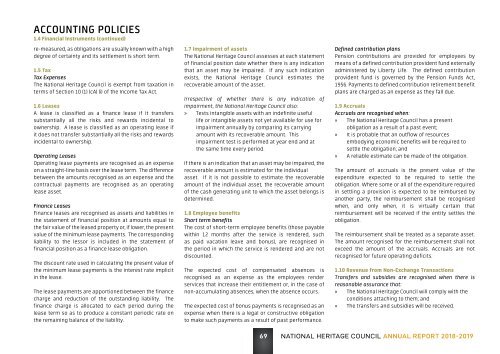2018-19 Annual Report
You also want an ePaper? Increase the reach of your titles
YUMPU automatically turns print PDFs into web optimized ePapers that Google loves.
ACCOUNTING POLICIES<br />
1.4 Financial Instruments (continued)<br />
re-measured, as obligations are usually known with a high<br />
degree of certainty and its settlement is short term.<br />
1.5 Tax<br />
Tax Expenses<br />
The National Heritage Council is exempt from taxation in<br />
terms of Section 10 (1) (cA) (i) of the Income Tax Act.<br />
1.6 Leases<br />
A lease is classified as a finance lease if it transfers<br />
substantially all the risks and rewards incidental to<br />
ownership. A lease is classified as an operating lease if<br />
it does not transfer substantially all the risks and rewards<br />
incidental to ownership.<br />
Operating Leases<br />
Operating lease payments are recognised as an expense<br />
on a straight-line basis over the lease term. The difference<br />
between the amounts recognised as an expense and the<br />
contractual payments are recognised as an operating<br />
lease asset.<br />
Finance Leases<br />
Finance leases are recognised as assets and liabilities in<br />
the statement of financial position at amounts equal to<br />
the fair value of the leased property or, if lower, the present<br />
value of the minimum lease payments. The corresponding<br />
liability to the lessor is included in the statement of<br />
financial position as a finance lease obligation.<br />
The discount rate used in calculating the present value of<br />
the minimum lease payments is the interest rate implicit<br />
in the lease.<br />
The lease payments are apportioned between the finance<br />
charge and reduction of the outstanding liability. The<br />
finance charge is allocated to each period during the<br />
lease term so as to produce a constant periodic rate on<br />
the remaining balance of the liability.<br />
1.7 Impairment of assets<br />
The National Heritage Council assesses at each statement<br />
of financial position date whether there is any indication<br />
that an asset may be impaired. If any such indication<br />
exists, the National Heritage Council estimates the<br />
recoverable amount of the asset.<br />
Irrespective of whether there is any indication of<br />
impairment, the National Heritage Council also:<br />
»»<br />
Tests intangible assets with an indefinite useful<br />
life or intangible assets not yet available for use for<br />
impairment annually by comparing its carrying<br />
amount with its recoverable amount. This<br />
impairment test is performed at year end and at<br />
the same time every period.<br />
If there is an indication that an asset may be impaired, the<br />
recoverable amount is estimated for the individual<br />
asset. If it is not possible to estimate the recoverable<br />
amount of the individual asset, the recoverable amount<br />
of the cash generating unit to which the asset belongs is<br />
determined.<br />
1.8 Employee benefits<br />
Short term benefits<br />
The cost of short-term employee benefits (those payable<br />
within 12 months after the service is rendered, such<br />
as paid vacation leave and bonus), are recognised in<br />
the period in which the service is rendered and are not<br />
discounted.<br />
The expected cost of compensated absences is<br />
recognised as an expense as the employees render<br />
services that increase their entitlement or, in the case of<br />
non-accumulating absences, when the absence occurs.<br />
The expected cost of bonus payments is recognised as an<br />
expense when there is a legal or constructive obligation<br />
to make such payments as a result of past performance.<br />
69<br />
Defined contribution plans<br />
Pension contributions are provided for employees by<br />
means of a defined contribution provident fund externally<br />
administered by Liberty Life. The defined contribution<br />
provident fund is governed by the Pension Funds Act,<br />
<strong>19</strong>56. Payments to defined contribution retirement benefit<br />
plans are charged as an expense as they fall due.<br />
1.9 Accruals<br />
Accruals are recognised when:<br />
»»<br />
The National Heritage Council has a present<br />
obligation as a result of a past event;<br />
»»<br />
It is probable that an outflow of resources<br />
embodying economic benefits will be required to<br />
settle the obligation; and<br />
»»<br />
A reliable estimate can be made of the obligation.<br />
The amount of accruals is the present value of the<br />
expenditure expected to be required to settle the<br />
obligation. Where some or all of the expenditure required<br />
in settling a provision is expected to be reimbursed by<br />
another party, the reimbursement shall be recognised<br />
when, and only when, it is virtually certain that<br />
reimbursement will be received if the entity settles the<br />
obligation.<br />
The reimbursement shall be treated as a separate asset.<br />
The amount recognised for the reimbursement shall not<br />
exceed the amount of the accruals. Accruals are not<br />
recognised for future operating deficits.<br />
1.10 Revenue from Non-Exchange Transactions<br />
Transfers and subsidies are recognised when there is<br />
reasonable assurance that:<br />
»»<br />
The National Heritage Council will comply with the<br />
conditions attaching to them; and<br />
»»<br />
The transfers and subsidies will be received.


